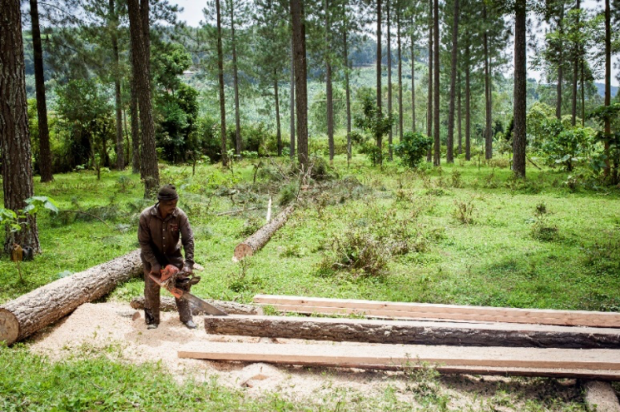Ugandan forests need SMEs for sustainable production
Discussion details
Uganda is approaching a tipping point for forest and biodiversity loss. However, it is possible to reverse this trend, provided that targeted efforts are made in conservation and sustainable production. Smallholders and SMEs can play a major role in enhancing sustainable forest-based value chains, aligned with an inclusive green economic pathway.
On 20 September 2022 a DG INTPA webinar will also explore this issue, stay tuned.
Experts have warned that, at current rates of deforestation and if business-as-usual continues, Uganda’s natural forests face total extinction by 2050 (Deforestation in Uganda: Impact and Solutions- The Borgen Project). The country’s economic development to date has been largely based on depletion of natural capital. It has lost one third of its natural forests since 1990, mostly due to agricultural expansion, extraction of wood fuel and illegal logging (FRA platform (fao.org)). There is an urgent need to transition towards a green growth path, maintaining the health and integrity of forests and other ecosystems. Fortunately, there is also the political will and commercial opportunity to do so.
During a visit to Uganda by the Forests for the Future Facility (F4) to assist the EU Delegation to develop an EU-Uganda Forest Partnership agreement, we found that there are promising opportunities to develop forest-based value chains that contribute to a green transition and benefit local stakeholders. “The interest to grow trees is increasing day by day and it is hoped that this will culminate in the establishment of a thriving and sustainable timber industry in Uganda,” said Dennis David Kavuma, general manager of the Uganda Timber Growers Association (UTGA), in an interview to F4.
Over the past 20 years, with EU support, private growers have established almost 100 000 hectares of commercial plantation on formerly deforested areas. (Sawlog Production Grant Scheme III (mwe.go.ug)). In addition, farmers have developed agroforestry systems and started to restore natural forests. Today, wood used in industry is primarily sourced from private plantations. This has relieved the pressure on natural forests from illegal and unsustainable logging. However, there are still major challenges to conserving remaining forests and restoring degraded natural forests.
Uganda, in common with other African countries experiencing population growth and increased urbanisation, faces a growing demand for nature-based and forest products (timber products, wood fuel, non-timber forest products). Wood products, for example, are needed by the construction industry, which is booming in urban hubs: over 40 000 people need a home every day in sub-Saharan Africa. However, wood processing industries currently produce mostly low value-added products, with obsolete technologies and high levels of wastage. Currently, most African countries are net importers of wood products. In 2021, Uganda had a negative trade deficit of wood products worth EUR 40 million (FAOSTAT).
The country clearly has the opportunity to become a hub of wood product industries in East Africa. The plantations owned by small, medium and large-scale forestry operators can feed valuable raw material to companies – most of them SMEs – that produce various sought-after products for local and regional markets. In addition to its plantations, the country has several advantages compared to its neighbours, such as its strategic location close to regional growth centres, emerging infrastructure and a dynamic business environment. There are also challenges, especially in governance and skills, which translate into high risks for investors and limited access to long-term sustainable finance. Existing industries are currently unable to use the forecasted produce of sustainable plantations: growers are today producing 0.4 million m3 of roundwood a year, which exceeds current processing capacities. By 2030, plantations could produce over 2 million m3 of roundwood sustainably per year. This is a major opportunity for local SMEs to add value and generate jobs.
The EU and other developing partners already support Ugandan foresters – smallholders and SMEs - and there are plans for further assistance. Uganda is among the first countries to establish a Forest Partnership agreement with the EU. To mobilise private finance, it is crucial to share and reduce the risks of long-term investments and to ensure that forests are used in a sustainable and inclusive manner. There are also significant opportunities to scale up production of non-wood products, and to promote conservation with carbon and biodiversity credits.
To explore this topic, the European Commission’s Directorate General for International Partnerships (DG INTPA) will host a webinar, Forest-based value chains with focus on wood products, in September 2022 (date tbc), with international experts. It is being organised by the Forests for the Future Facility, which provides technical assistance to the European Commission to contribute to partner countries’ efforts towards healthy forest ecosystems and economic growth in Asia, Africa, the Caribbean and Latin America. The support services include the development of sustainable forest management and forest-related value chains.
Petri Lehtonen, Forests for the Future Facility
This article has been prepared by the Forests for Future Facility. It does not represent the official view of the European Union.


Log in with your EU Login account to post or comment on the platform.